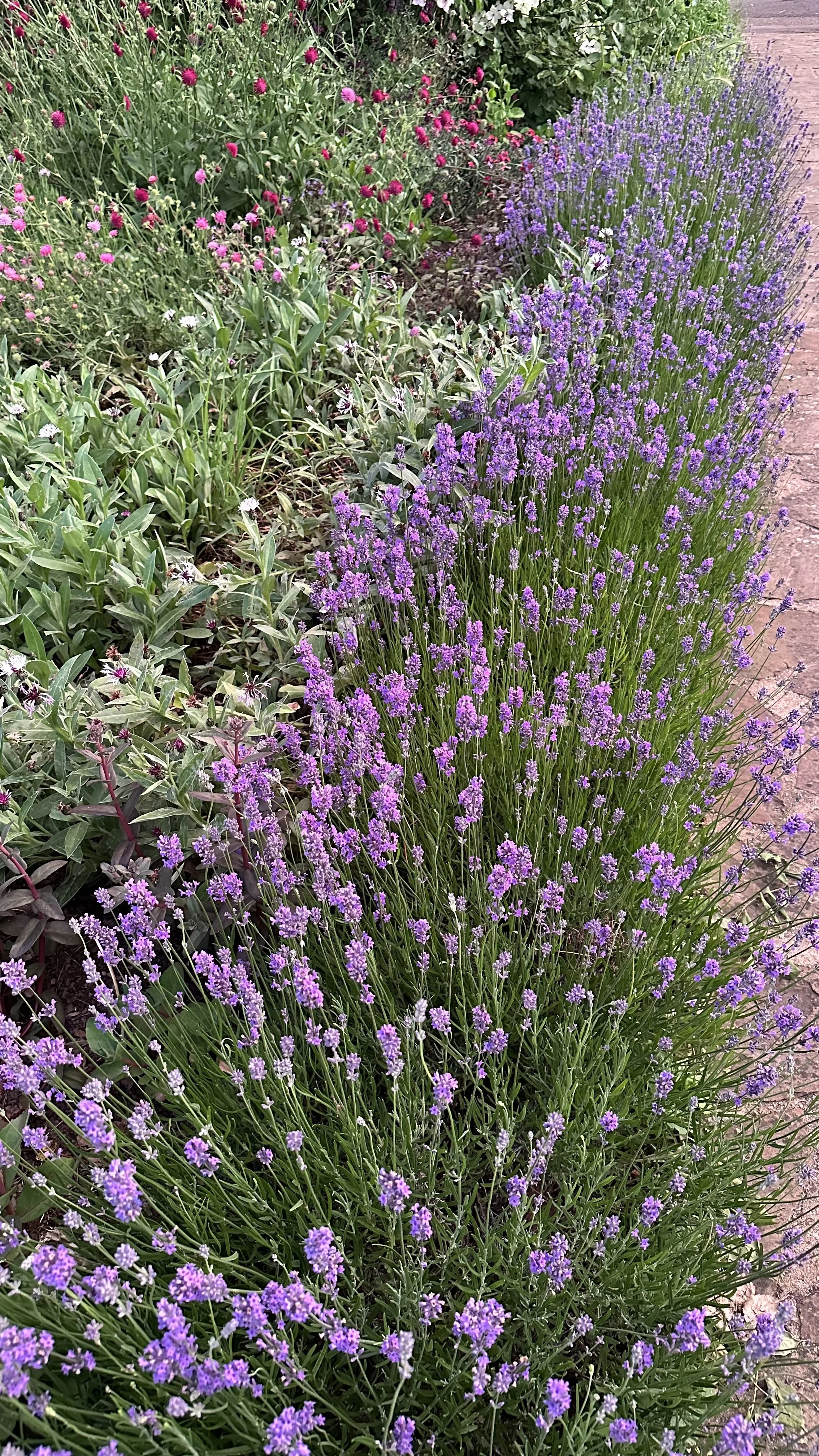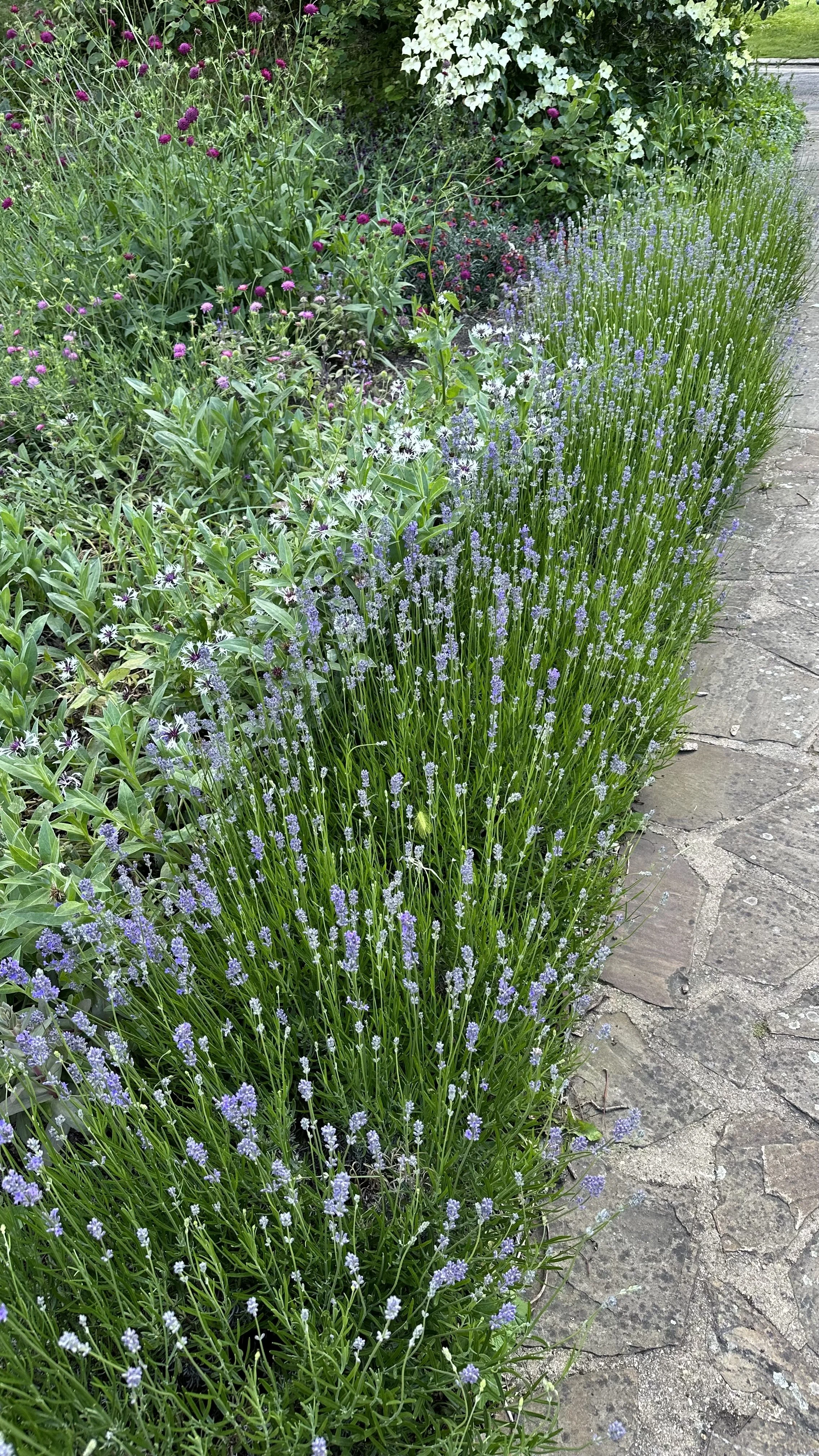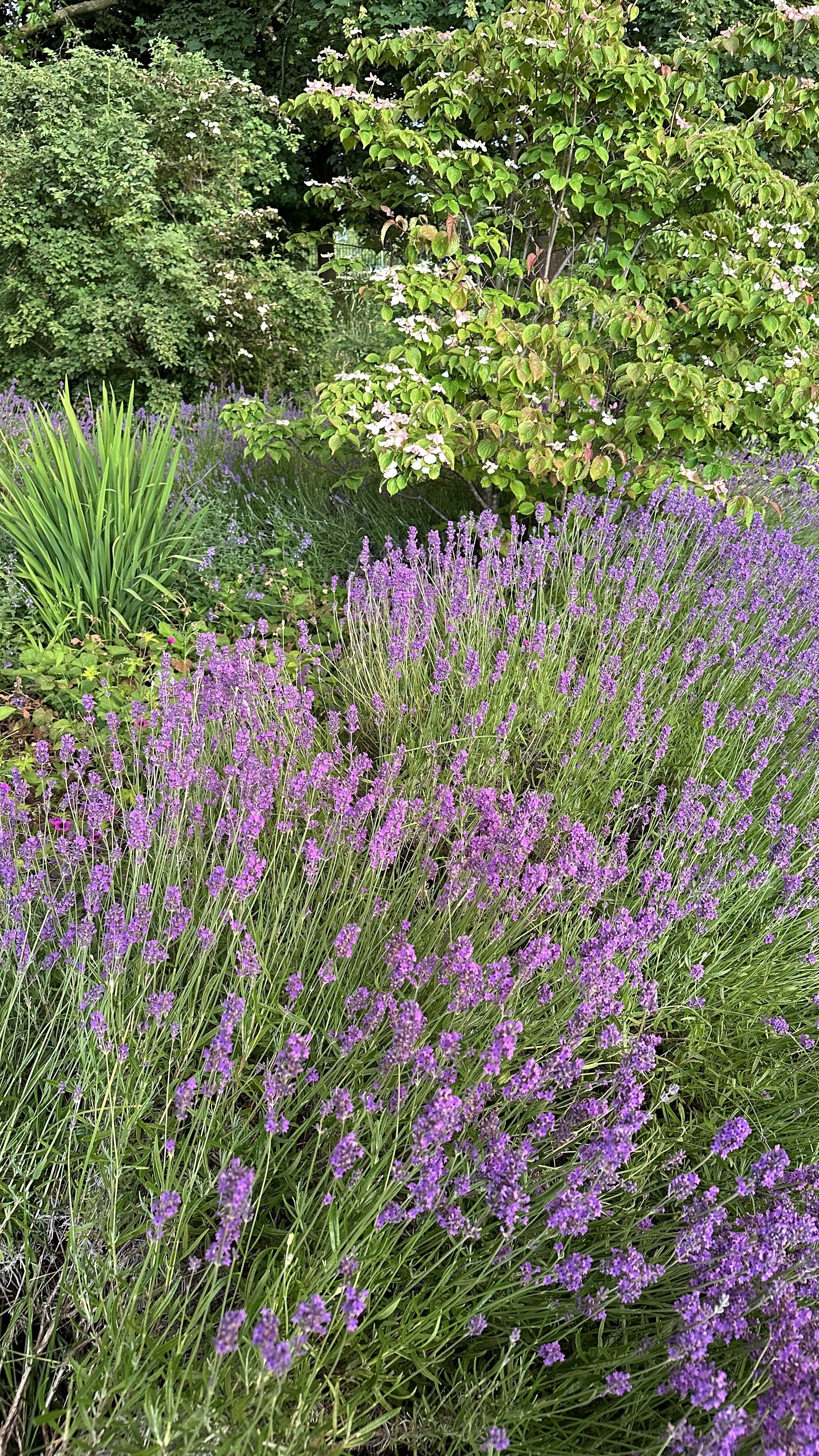How to Create a Lavender Hedge
This website is reader-supported - thank you! This post may contain affiliate links. As an Amazon Associate, I earn from qualifying purchases at no extra cost to you.
Creating a lavender hedge is both a practical and beautiful way to define the boundaries of your garden.
With their fragrance, stunning purple blooms, and drought tolerant nature, lavender plants are a top choice among hedging plants.
The benefits of a lavender hedge goes beyond its beauty, offering a way to transform garden edges into displays of both color and scent.
I have dedicated this guide to exploring the art of lavender hedging, focusing on the selection of suitable hedge plants from the large amount of lavender varieties available.
Whether you're looking to establish a new boundary or enhance an existing one, understanding the nuances of different lavender varieties and their maintenance needs is key to achieving an established hedge.
Let's explore how to cultivate and care for a lavender hedge, ensuring it becomes a highlight in your garden for years to come.
To learn more about growing lavender, check out my guides:
Lavender Companion Plants: Enhancing Your Herb Garden
Why Choose Lavender for Hedging?
When it comes to selecting the perfect plants for your garden hedge, there’s something undeniably beautiful about lavender that sets it apart from the rest.
Let’s delve into the reasons why lavender stands out as a stellar choice for hedging.
Fragrance:
Beyond its visual appeal, lavender emits a soothing, fragrant aroma that can fill your garden.
This scent also invites a variety of pollinators into your garden.
Bees and butterflies are particularly attracted to lavender, turning your garden into a bustling ecosystem.
Durability and Low Maintenance:
Lavender is renowned for its hardiness.
Once established, these plants are incredibly resilient, capable of withstanding drought conditions and requiring minimal watering.
This makes lavender an ideal choice if you are looking for low-maintenance options.
Additionally, lavender is relatively resistant to common pests and diseases, ensuring your hedge remains healthy and vibrant with minimal intervention.
For more drought tolerant plant inspiration, check out my guide 20 Easy to Grow Drought Tolerant Annuals.
Versatility:
Lavender is a versatile plant that can thrive in a range of environments.
Whether you're gardening in the cooler climates where English lavender (Lavandula angustifolia) flourishes or in warmer regions suited to French lavender (Lavandula stoechas) and hybrids like 'Grosso', there’s a variety of lavender that can adapt to your specific conditions.
Multiple Uses:
Beyond its role as a hedge, lavender offers a multitude of uses.
Its flowers can be harvested for making lavender oil, used in aromatherapy, or dried to create fragrant sachets and potpourris.
Lavender is also great for keeping cats away from your garden, to learn more check out my guide:
Plants That Deter Cats: A Natural Solution to Keep Cats at Bay
To learn more about growing lavender, check out my guides:
Selecting the Best Lavender for Hedging
Choosing the right lavender variety for your hedge is crucial to achieving the desired look, fragrance, and durability in your garden.
Lavender varieties differ significantly in size, bloom time, color, and hardiness, impacting their suitability for hedging.
Let's explore how to select the best lavender for your hedging project.
Understand the Varieties:
The two most popular species for hedging are English lavender (Lavandula angustifolia) and French lavender (Lavandula stoechas), with numerous cultivars available within each species.
English lavender is celebrated for its hardiness, enduring cold winters and producing intensely fragrant flowers.
On the other hand, French lavender, with its distinctive butterfly-like flower bracts, offers longer blooming periods in warmer climates.
Climate Considerations:
Your local climate plays a significant role in selecting the right type of lavender.
Lavandula angustifolia is well-suited to cooler climates, thriving in USDA zones 5 through 9.
It's renowned for its ability to withstand frost and still produce abundant, fragrant flowers.
For gardeners in warmer regions, Lavandula stoechas and its hybrids, which prefer USDA zones 8 through 10, can be more appropriate, offering robust growth and resilience to heat.
Growth Habits and Size:
When planning a hedge, consider the mature size of the lavender variety.
Some lavenders, like 'Hidcote' and 'Munstead' (both English lavenders), are more compact, making them ideal for low hedges or borders.
Conversely, varieties like 'Grosso' lavender (a hybrid known for its large size and long stems) are better suited for taller hedges.
The growth habit, whether upright or sprawling, will also affect the hedge's appearance and maintenance needs.
Flowering and Fragrance:
The blooming period and the fragrance are also vital considerations.
While all lavender varieties offer the classic scent, some, like English lavender, are particularly prized for their potent aroma, making them excellent for hedging near outdoor seating areas or windows where their fragrance can be enjoyed.
Additionally, consider bloom time; some varieties offer a longer display of color, while others might bloom earlier or later in the season.
Maintenance and Care:
While lavender is generally low-maintenance, some varieties may require more pruning to maintain a neat hedge appearance.
English lavender, for example, benefits from annual pruning to keep it dense and to prevent it from becoming woody.
This maintenance can influence your choice if you prefer a more hands-off approach or have a large hedge to manage.
Aesthetic Preferences:
Finally, personal aesthetic preferences play a role.
Lavender varieties come in shades ranging from deep purple to soft lilac, and even white or pink.
Select a color that complements your garden's palette and meets your visual expectations for the hedge.
Recommended Varieties for Hedging:
Lavandula angustifolia 'Hidcote':
A popular choice for its deep purple flowers and compact growth, ideal for formal hedges.
Here is the one I recommend growing:
Lavandula angustifolia 'Munstead':
Another English variety, slightly larger than 'Hidcote', with vibrant flowers and a sweet fragrance.
Here is the one I recommend growing:
Lavandula x intermedia 'Grosso':
Known for its large size and long-lasting, highly fragrant blooms.
It's an excellent choice for taller, more informal hedges.
Here is the one I recommend growing:
Lavandula stoechas:
For warmer climates, this species offers unique flower heads and a lengthy blooming period.
Here is the one I recommend growing:
To learn how to propagate lavender, check out my guide:
To learn more about lavender, check out my guide:
Planning Your Lavender Hedge
Creating a successful lavender hedge begins long before the first plant is in the ground.
Thorough planning is key to ensuring that your hedge not only looks beautiful but also thrives in its environment.
Here are essential steps and considerations to guide you through the planning process:
Assess Your Garden Space:
Start by evaluating the area where you intend to plant the hedge.
Consider the amount of daily sunlight it receives; lavender thrives in full sun, requiring at least six hours of direct sunlight per day.
A south-facing or west-facing garden location is best.
Also, assess the soil type; lavender prefers well-draining soil to prevent root rot.
Soil Preparation:
Lavender’s success is heavily dependent on proper soil conditions.
If your soil is heavy or clay-like, incorporate generous amounts of organic matter or sand to improve drainage.
Testing your soil's pH is also a good idea as lavender prefers slightly alkaline conditions.
Adjust the soil pH if necessary using lime (to increase pH) or sulfur (to decrease pH).
Here is the soil pH tester that I recommend using:
Decide on the Hedge Layout:
Determine whether you want a formal, straight-edged hedge or a more informal, natural-looking border.
This decision will influence the spacing and arrangement of your lavender plants.
For a denser hedge, consider planting in a staggered double row; this ensures that the hedge will be thick and full from the ground up.
Spacing Considerations:
Proper spacing is crucial for the health of your lavender hedge.
As a general rule, plant lavender at a distance equal to their mature spread to allow for ample air circulation and growth.
Typically, this means setting plants about 18 to 24 inches apart.
If you're planting in staggered rows, adjust the spacing accordingly to ensure each plant receives enough sunlight.
Plan for Growth:
Anticipate the mature size of your lavender plants to prevent overcrowding and to maintain the hedge's shape with minimal pruning.
Understanding the growth habit and rate of your chosen variety will help you maintain the hedge's appearance and health over time.
Consider Maintenance Needs:
Be realistic about the time and effort you can dedicate to maintaining your lavender hedge.
While lavender is relatively low-maintenance, it does require annual pruning to keep it looking its best and to prevent it from becoming woody.
Watering and Irrigation:
While establishing your lavender plants, they will need regular watering until they are well-rooted.
Plan an irrigation strategy that allows you to water the plants efficiently without leaving the soil wet for extended periods.
A soaker hose is often recommended for lavender, as it targets the roots directly and keeps foliage dry.
Here is the soaker hose I recommend:
For more watering tips, check out my guides Water Butts: Sustainable Water Storage for Your Garden and How to Use Watering Globes.
Think About Companion Plants:
If you’re considering adding companion plants to your hedge, choose species that share similar growing requirements.
Herbs like rosemary and thyme or drought-tolerant perennials can complement your lavender hedge beautifully without competing for resources.
To learn more about this, check out my guide Lavender Companion Plants: Enhancing Your Herb Garden.
Planting and Growing Your Lavender Hedge
Turning the vision of a lavender hedge into a reality is the fun part.
From the right timing to the planting technique, each step plays a crucial role in the success of your lavender hedge.
Follow these steps to ensure your lavender plants get the best start and continue to grow healthily.
Timing is Key:
The optimal time to plant lavender is in the spring after the risk of frost has passed.
This gives the plants a full growing season to establish themselves before winter.
In warmer climates where frost is less of a concern, planting in the fall is also an option, allowing the roots to establish during the cooler months.
Planting Lavender:
When planting, make sure the root ball is level with the soil surface.
Dig a hole slightly larger than the root ball of your lavender plant.
Gently loosen the roots before placing the plant in the hole.
Backfill with soil, pressing down firmly to eliminate air pockets.
Space the plants according to the variety's mature size, generally 18 to 24 inches apart, to allow for air circulation and growth.
Watering After Planting:
Initially, your lavender plants will need regular watering to help establish roots.
Water deeply but infrequently, allowing the soil to dry out somewhat between watering sessions.
Avoid overhead watering to prevent wet foliage, which can lead to fungal diseases.
Mulching:
Apply a light layer of mulch around the plants to help retain moisture and suppress weeds.
However, keep mulch away from the plant's base to prevent moisture buildup around the stems.
Here is the mulch I recommend:
Fertilizing:
Lavender does not require high levels of fertility.
Over-fertilizing can lead to excessive vegetative growth at the expense of blooms.
If necessary, apply a balanced, slow-release fertilizer sparingly in the spring.
Here is the slow-release fertilizer I recommend:
Pruning and Shaping:
Prune your lavender plants early in the spring to shape the hedge and encourage bushy growth.
Remove any dead or damaged wood, and cut back about a third of the previous year's growth to promote new shoots.
Annual pruning is crucial to prevent the plants from becoming woody and to maintain the desired hedge form.
These garden pruners are perfect for the job:
Dealing with Pests and Diseases:
Lavender is relatively resistant to pests and diseases, but it's important to watch for common issues like fungal diseases, which can arise in conditions of poor air circulation or wet soil.
Ensure good spacing and practice crop rotation if planting in garden beds previously used for other susceptible plants.
Long-term Care:
As your lavender hedge matures, continue to monitor soil moisture, especially in extreme heat or drought conditions.
Established lavender plants are drought-tolerant but will benefit from occasional deep watering during prolonged dry spells.
To learn more about lavender, check out my guides:
Lavender Hedge Maintenance
Maintaining a lavender hedge involves regular care.
Lavender is relatively low-maintenance once established, but certain practices will help prolong the life of your hedge and keep it looking its best.
Pruning:
Pruning is perhaps the most crucial aspect of lavender hedge maintenance.
Lavender should be pruned once a year, ideally in late summer after blooming has finished.
This timing allows the plants to harden off before winter.
Pruning not only shapes the hedge but also encourages new growth, prevents the center of the plants from becoming woody, and promotes denser, more prolific flowering.
Use sharp, clean shears to remove about one-third of the current year's growth, making sure not to cut into old wood, as lavender can be slow to recover from such pruning.
Weed Control:
Keep the area around your lavender plants free of weeds.
Weeds can compete with lavender for nutrients and water, as well as hinder air circulation around the plants.
Use mulch to suppress weed growth, but keep it away from the base of the plants to avoid excess moisture buildup.
Disease and Pest Management:
Lavender is generally resistant to pests and diseases, especially when grown under optimal conditions.
However, it's still important to monitor your hedge for signs of stress or infestation.
Common issues include fungal diseases in humid conditions and pests like aphids and whiteflies.
Promote good air circulation by not overcrowding plants and by pruning regularly.
Winter Care:
In colder climates, lavender may need some protection from harsh winter conditions.
Although many varieties are hardy, young plants or those in particularly cold areas can benefit from a light mulch of straw or evergreen branches after the ground freezes.
This should be removed in early spring to allow new growth to emerge.
Rejuvenation Pruning:
If a lavender hedge has been neglected and has become woody and sparse, consider rejuvenation pruning in early spring.
This involves cutting back one-third to one-half of the plant, avoiding cutting into the oldest wood.
Rejuvenation pruning can stimulate new growth from the base, but it's risky and may not always be successful.
It's better to prevent the need for such drastic measures by annual pruning.
Pin this post to save it for later!












































